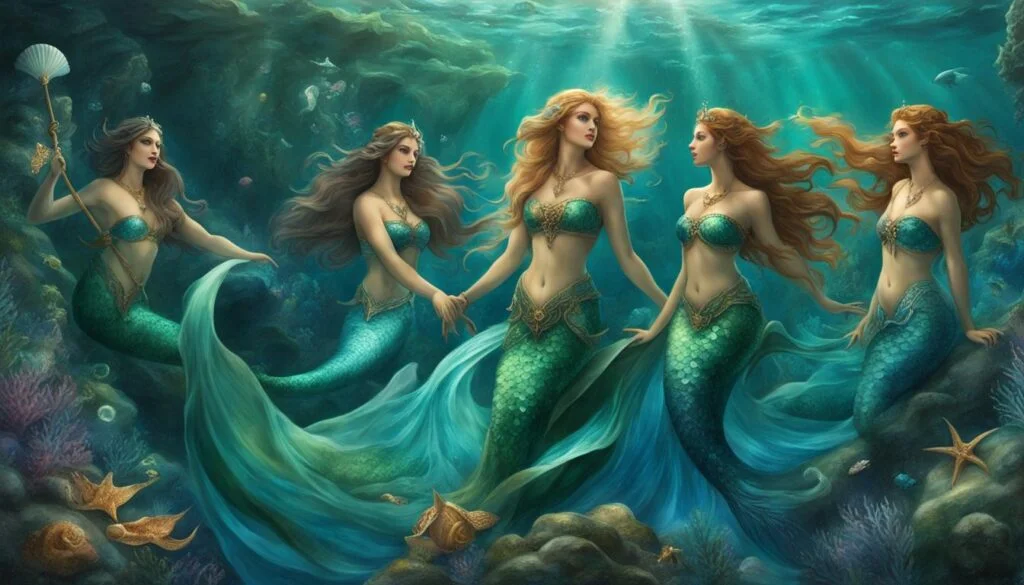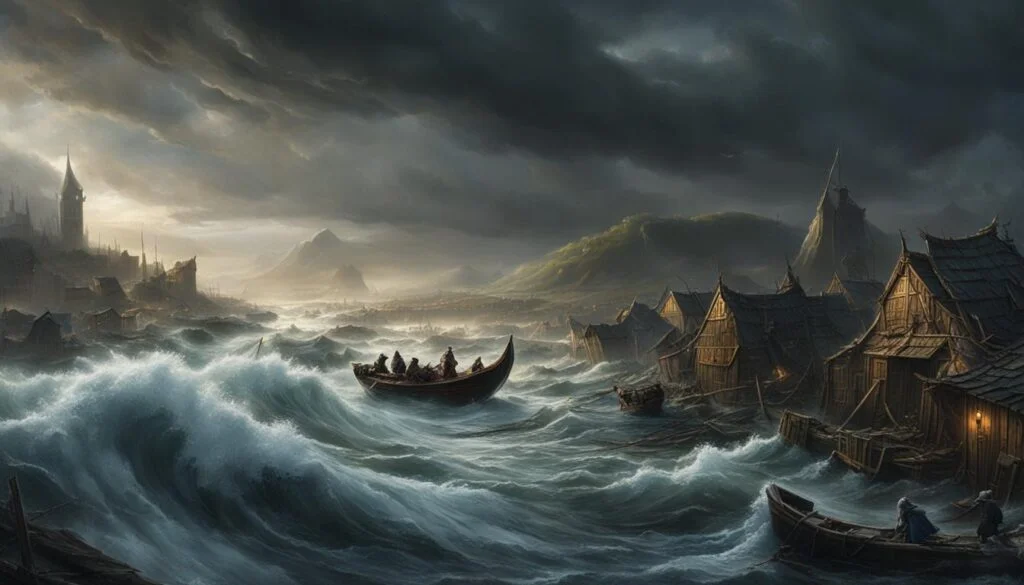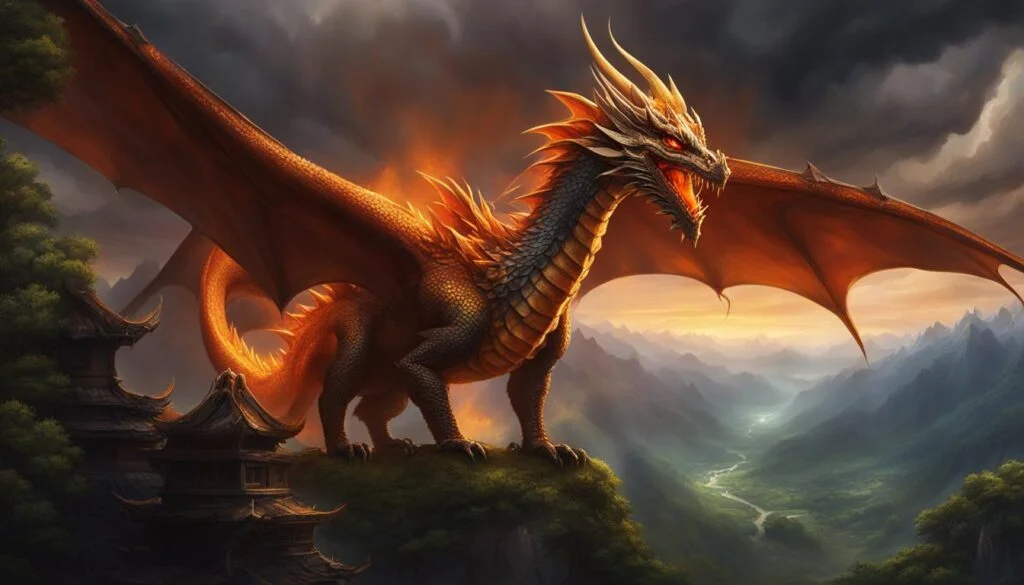According to folklore, mermaids are aquatic creatures with the head and upper body of a female human and the tail of a fish. This concept of mermaids appears in the folklore of many cultures worldwide, including Europe, Asia, and Africa. But what about Norse mythology? Does it have mermaids?
In Norse mythology, which encompasses the ancient Norse pagans’ beliefs and legends, there are mentions of water spirits and various mythological creatures. However, there is no specific reference to mermaids in Norse mythological texts.
Key Takeaways:
- Mermaids are not part of Norse mythology, according to the available mythological texts.
- Norse mythology does include various water spirits and mythological creatures, but none are specifically identified as mermaids.
- The concept of mermaids is prevalent in other folklore and cultural traditions.
- Mermaid-like creatures can be found in Faroese, Scottish, Irish, and Icelandic folklore.
- While Norse mythology lacks mermaids, the artistic interpretations and cultural fascination with mermaids continue to play a significant role in literature and popular culture.
The Concept of Mermaids in Folklore
Mermaids have been a part of folklore in various cultures around the world. These mythical creatures are often associated with perilous events such as floods, storms, shipwrecks, and drownings. However, folklore also portrays mermaids as beings capable of bestowing boons or even falling in love with humans.
In Norse mythology, there are mentions of water spirits and mythological creatures, such as the Nereids, Njord, and Rán. These beings possess various powers and play significant roles in Norse mythology. However, there is no specific mention of mermaids in the Norse mythological texts.
Despite the absence of mermaids in Norse mythology, the concept of mermaid-like creatures continues to captivate the imagination and has become a popular topic in folklore and literature. In subsequent sections, we will explore the influence of sirens on mermaid depictions, historical accounts and sightings, mermaid representations in art and literature, as well as other folklore and mythology where mermaid-like creatures appear.
The Influence of Sirens on Mermaid Depictions
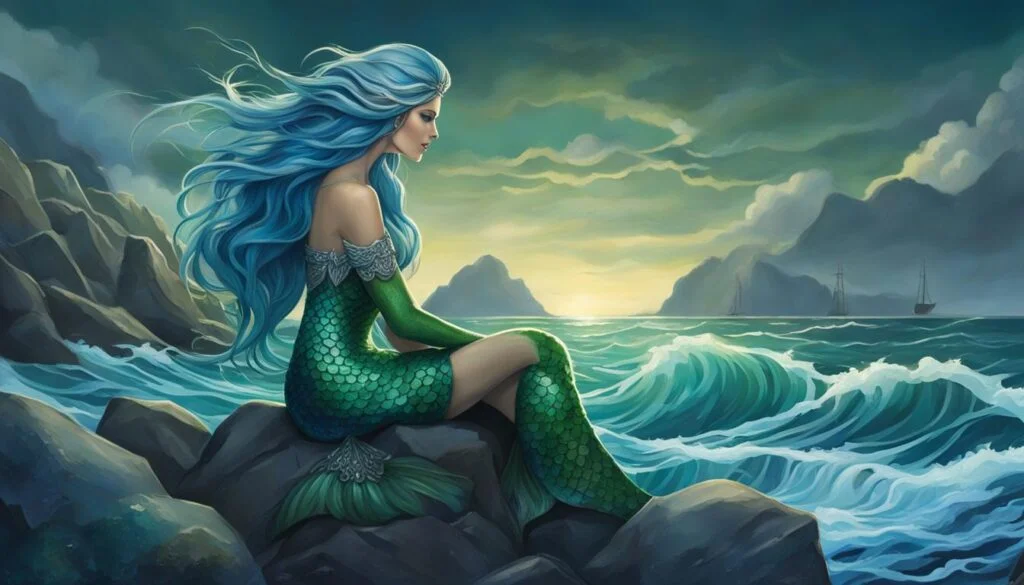
The concept of mermaids as beautiful, seductive singers has captivated the imagination for centuries. In Norse folklore and mythology, while there is no specific mention of mermaids, the influence of other mythological creatures, such as sirens, may have played a role in the development of mermaid depictions.
Sirens, originally depicted as half-birdlike creatures in Greek mythology, later came to be portrayed as half-fishlike during the Christian era. The allure and enchanting singing of sirens, as well as their association with the sea, may have inspired the concept of mermaids in various folklore and literature, including Norse folklore.
The mesmerizing and dangerous nature of sirens, combined with their association with the ocean, likely influenced the romanticized and mythical aspects often attributed to mermaids in different cultural traditions.
While mermaids may not have a direct presence in Norse mythology, the impact of sirens on these depictions highlights the interconnectedness and cross-cultural influences within mythological and folkloric narratives.
Historical Accounts and Sightings

Although there are no specific historical accounts or sightings of mermaids in Norse mythology, there have been reports of mermaid sightings throughout history. These sightings have captured the imaginations of people around the world, fueling the fascination with these mythical creatures.
One notable historical account that often comes up in discussions of mermaids is the sighting by Christopher Columbus during his exploration of the Caribbean. Columbus reported seeing mermaids, describing them as having “the shape of a woman in everything, but the face, which was strong and masculine.” However, it is now believed that these sightings were likely misidentifications of manatees or similar aquatic mammals.
It is important to note that mermaid sightings are not unique to Norse mythology or any specific culture. Throughout history, similar reports have been made in various parts of the world, often in coastal regions. However, it is crucial to approach these accounts with skepticism, as there is no scientific evidence to support the existence of mermaids outside of folklore and mythology.
Despite the lack of concrete evidence, the allure of mermaids continues to captivate our imagination. Their enchanting depiction in art, literature, and popular culture only serves to reinforce the enduring fascination with these mysterious creatures.
Mermaids in Art and Literature
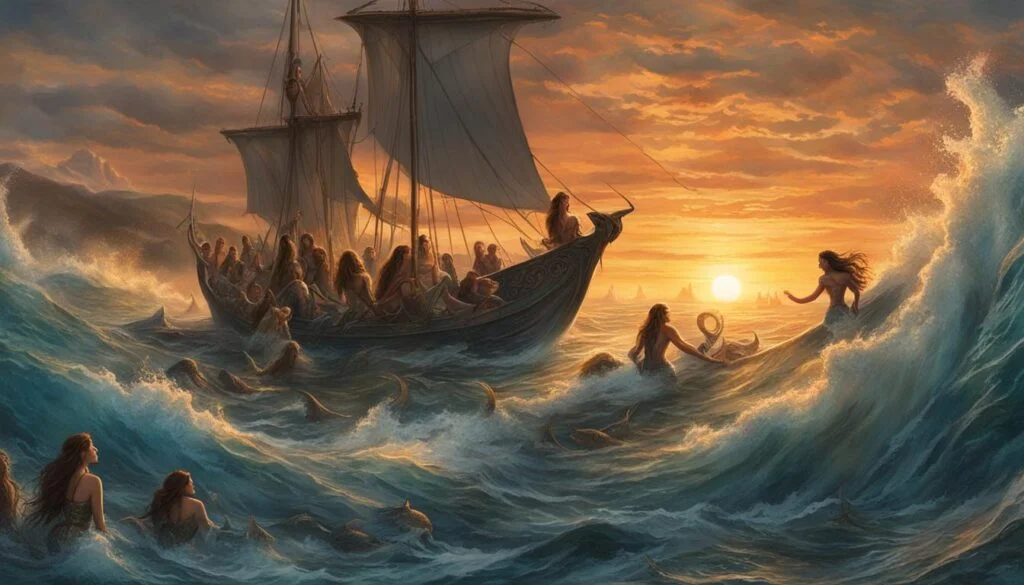
Mermaids have long been a captivating subject in the realms of art and literature. While there may not be direct references to mermaids in Norse mythology, the concept of aquatic beings and mythological creatures has inspired countless artistic interpretations.
One of the most famous examples of mermaid representation in literature is Hans Christian Andersen’s beloved fairy tale, “The Little Mermaid” (1836). This enchanting story showcases the allure and sacrifices of a young mermaid who yearns for love and humanity.
Mermaids have also made appearances in various other art forms. Operas such as “Rusalka” and “The Pearl Fishers” portray mermaid characters, capturing their mystique and allure through music and dramatic performances. Paintings, both classical and contemporary, have immortalized mermaids in their underwater realms, sometimes depicting them as enchanting seductresses or symbols of grace.
Mermaid-themed books, comics, animation, and live-action films have also gained popularity, further fueling the imagination of those fascinated by these magical beings. The allure of mermaids continues to inspire artists and storytellers to create captivating tales that explore themes of love, exploration, and the mysteries of the ocean.
Etymologies and Names
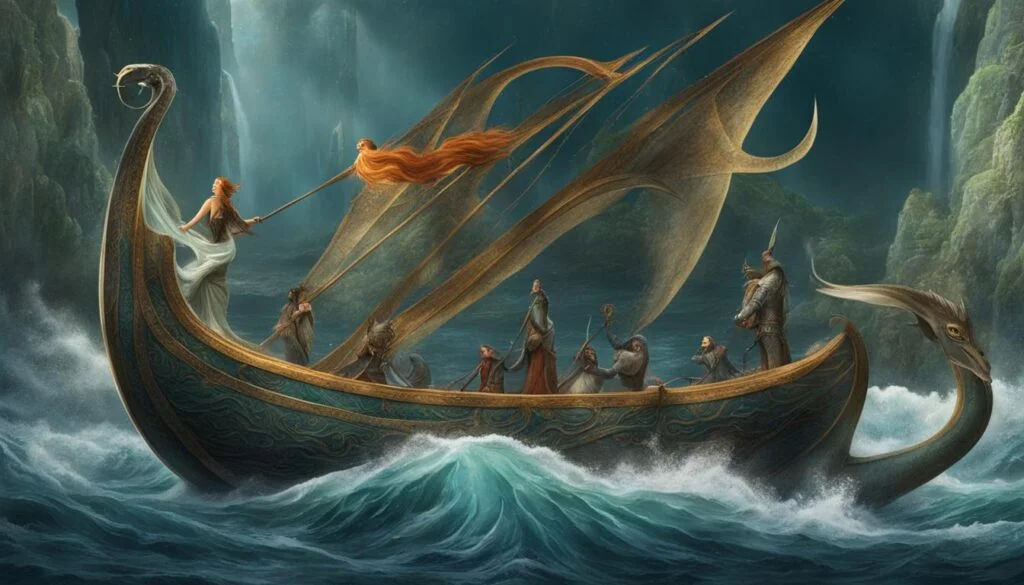
When exploring the origins of the word “mermaid,” we find its earliest attestation in Middle English. The term is derived from the combination of “mere” (meaning sea) and “maid” (meaning a young girl or unmarried woman). It is interesting to note that “maid” itself traces back to the Old English term “mægden.”
In different languages, related terms are used to refer to mermaids. For instance, in Dutch, the term “meermin” is used, while in Old Frisian, “merwîp” is used. The German language has the term “meerweib,” and “sjókona” is used in Icelandic. These variations reflect the cultural diversity and linguistic richness associated with the concept of mermaids.
In Norse mythology, water spirits and mythological creatures are encountered, but there is no specific Norse term exclusively used to denote mermaids. Instead, various names are given to these beings depending on their characteristics and roles within the mythology. Examples include the Nereids, who are sea nymphs, and Rán, who is the Norse goddess of the sea and storms.
Understanding the etymology and names associated with mermaids allows us to appreciate the linguistic diversity and cultural connections surrounding these mythical beings.
Origins and Folklore Variations
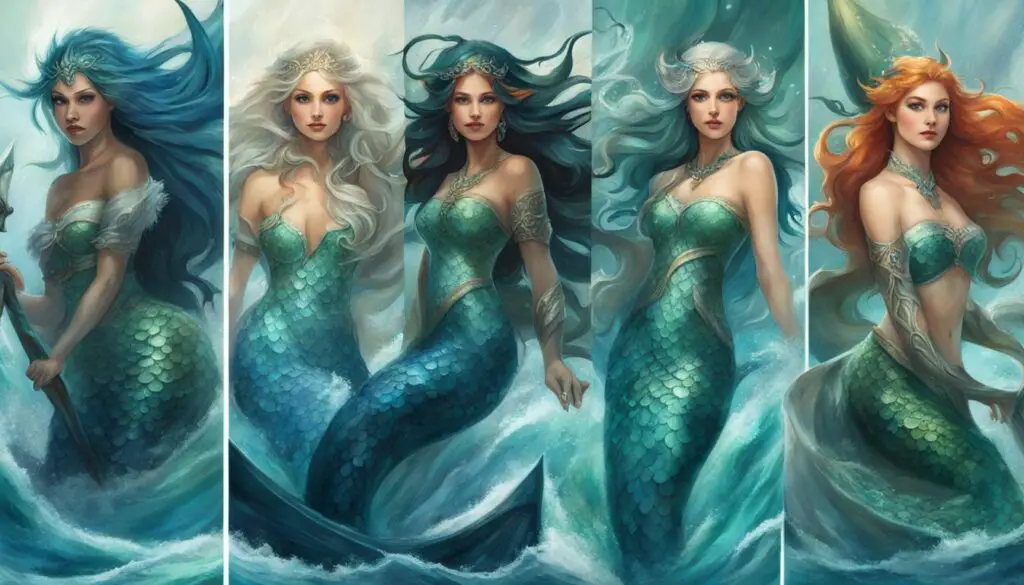
The origins of mermaids in folklore are fascinating and trace back to various cultures throughout history. While the exact origin remains unclear, the concept of mermaids has been present in myths, legends, and folklore across cultures.
In some folklore variations, mermaids are believed to be the souls of drowned men, haunting the bodies of water they perished in. These tales often associate mermaids with tragedy, portraying them as enchanting yet haunting figures.
Another interesting folklore variation presents mermaids as transformed pagan women banished by saints. These stories depict mermaids as both alluring and dangerous, with their enchanting songs luring unsuspecting sailors to their demise.
The myth of mermaids is not limited to one particular region or time period. In fact, mermaid folklore can be traced back to at least as ancient as the Viking Age. Variations of mermaids can be found in the folklore of Faroese, Scottish, Irish, and Icelandic cultures, among others.
These illustrations from different cultures illuminate the enduring presence of mermaids in folklore. As the myths and legends surrounding mermaids continue to captivate our imagination, their origins and variations offer a glimpse into the rich tapestry of human storytelling.
Mermaids in Other Folklore and Mythology
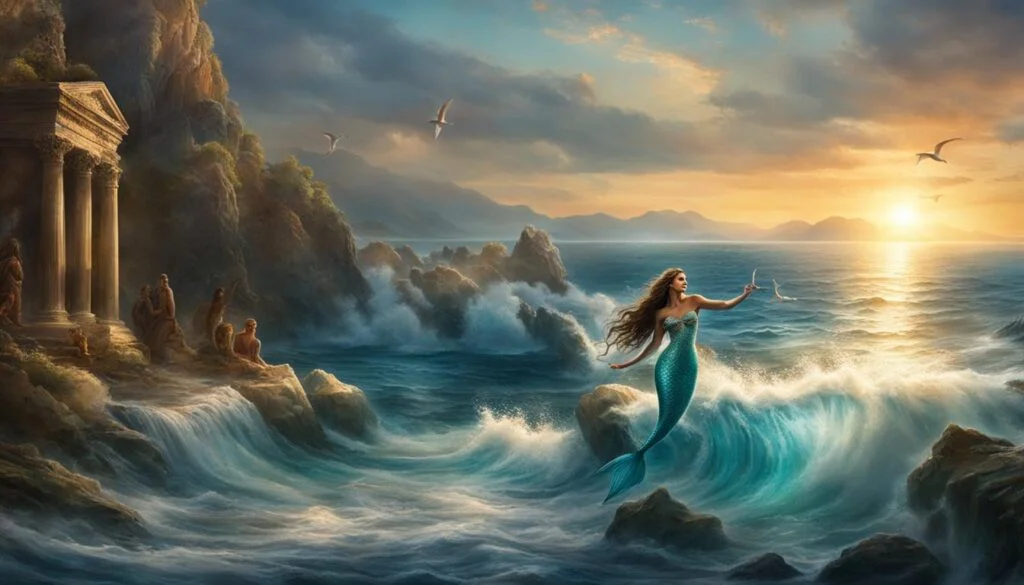
Mermaid-like creatures appear in various folklore and mythology traditions, not just in Norse mythology. For example, Faroese and Scottish mythology includes selkies, seals who have the ability to transform into human form when they remove their seal skins. These enchanting creatures are often associated with stories of love and loss, captivating the imagination of those who hear their tales.
Mythological figures like Atargatis, a deity associated with fertility and water in Assyrian and Syrian mythology, and the Nereids, water nymphs of Greek mythology, also bear resemblance to mermaids. These mythical beings possess both human and aquatic characteristics, existing at the intersection of two worlds.
Throughout different cultural traditions, the concept of mermaid-like creatures has permeated folklore and mythology, adding depth to the enduring fascination surrounding these captivating beings.
Mermaid Characters in Literature and Popular Culture
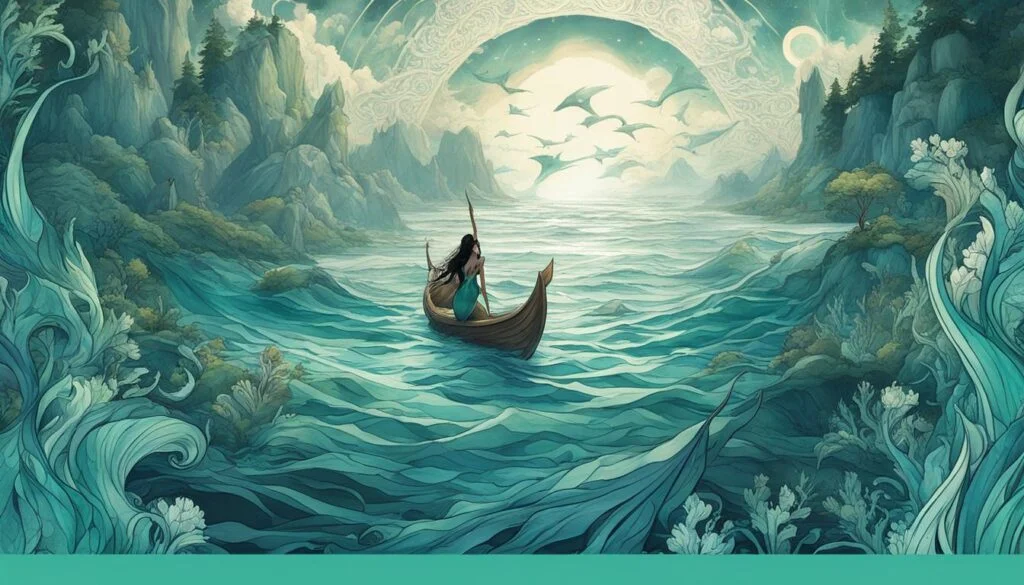
Mermaids have captured the hearts and imaginations of people throughout history, and their enchanting presence continues to thrive in literature and popular culture. These mystical beings have found their way into numerous literary works, becoming beloved characters that resonate with readers.
One iconic example of a mermaid character is Undine, a water nymph from Friedrich de la Motte Fouqué’s 1811 novella “Undine.” Undine’s story explores themes of love, identity, and sacrifice, showcasing the complexities of mermaid existence and their connection to human emotions.
Another prominent mermaid character is the Little Mermaid, popularized by Hans Christian Andersen’s fairy tale of the same name. This tale follows the journey of a young mermaid who longs to become human and experience love. The Little Mermaid has become a symbol of resilience, yearning, and the pursuit of one’s dreams.
Mermaids are also featured in various folklore-inspired stories, where they often serve as enchanting and mysterious creatures. These tales allow authors to delve into the depths of mermaid mythology, creating narratives that intertwine the human and aquatic worlds.
The allure of mermaids in literature extends beyond the written word. These captivating beings have also found their way into the realm of popular culture. They have been brought to life in films, television shows, and animated features, enchanting audiences of all ages.
Mermaids have made a splash in movies like Disney’s “The Little Mermaid” (1989), which introduced a new generation to the enduring story and its memorable characters. The film’s success sparked a wave of mermaid-themed entertainment that continues to influence pop culture to this day.
Mermaids can be found in various forms of artistic expression, from visual arts to music. Their beauty, mystique, and symbolic nature have inspired countless artists and musicians, creating a rich tapestry of mermaid-themed works.
Mermaids’ enduring presence in literature and popular culture reflects their timeless appeal, offering a glimpse into the mystical and mythical realm. Whether we encounter them in ancient folklore or modern-day adaptations, mermaid characters are a testament to the power of imagination and the enduring fascination with these enchanting sea creatures.
Conclusion
After exploring Norse mythology and delving into the concept of mermaids, it becomes evident that while Norse mythology contains references to various water spirits and mythological creatures, there is no specific mention of mermaids. The notion of mermaids seems to be more prominent in other folklore and cultural traditions.
However, despite their absence in Norse mythology, mermaid-like figures have left an indelible impact on art, literature, and popular culture. The allure and romanticism surrounding the idea of mermaids have captivated the imaginations of artists, writers, and audiences alike.
When approaching the topic of mermaids, it is crucial to have an understanding of their folklore origins and the artistic interpretations they have inspired. The concept of mermaids symbolizes the mystical and enchanting depths of the oceans, igniting our fascination with the unknown and the extraordinary.
FAQ
Does Norse mythology have mermaids?
According to folklore, there is no specific mention of mermaids in Norse mythology.
What mythological creatures are mentioned in Norse mythology?
Norse mythology includes various water spirits and mythological creatures such as the Nereids, Njord, and Rán.
Are mermaids associated with perilous events?
Yes, mermaids are often associated with events such as floods, storms, shipwrecks, and drownings in folklore.
Are there historical accounts or sightings of mermaids in Norse mythology?
While there are no specific historical accounts or sightings of mermaids in Norse mythology, there have been reports of mermaid sightings throughout history. However, these sightings have not been scientifically proven and may have been mistaken for other aquatic mammals.
Are mermaids depicted in art and literature?
Yes, mermaids have been a popular subject in art and literature for centuries. They have been featured in operas, paintings, books, comics, animation, and live-action films.
What is the origin of the word “mermaid”?
The English word “mermaid” has its earliest attestation in Middle English, derived from “mere” (sea) and “maid.” Other related terms in different languages include “mermin,” “merwîp,” “meerweib,” and “sjókona.”
Are there variations of mermaids in folklore?
Yes, the concept of mermaids appears in folklore from various cultures, with variations found in Faroese, Scottish, Irish, and Icelandic folklore.
Are there mermaid-like creatures in other mythologies?
Yes, other mythologies include mermaid-like creatures such as selkies in Faroese and Scottish mythology, and figures like Atargatis and the Nereids in different cultural traditions.
Are there mermaid characters in literature and popular culture?
Yes, mermaid characters have been featured in numerous literary works and have become popular in modern culture. Examples include characters like Undine, the Little Mermaid, and various mermaids depicted in folklore-inspired stories.
Can mermaids be considered part of Norse mythology?
While there is no specific mention of mermaids in Norse mythology, the concept of aquatic beings and mythological creatures in Norse folklore may have influenced artistic interpretations of mermaids.
What can we conclude about Norse mythology and mermaids?
While Norse mythology does not specifically include mermaids, the concept of mermaids is prevalent in other folklore and cultural traditions. However, the influence of mermaid-like figures in art, literature, and popular culture has contributed to the fascination and romanticism surrounding the idea of mermaids.


